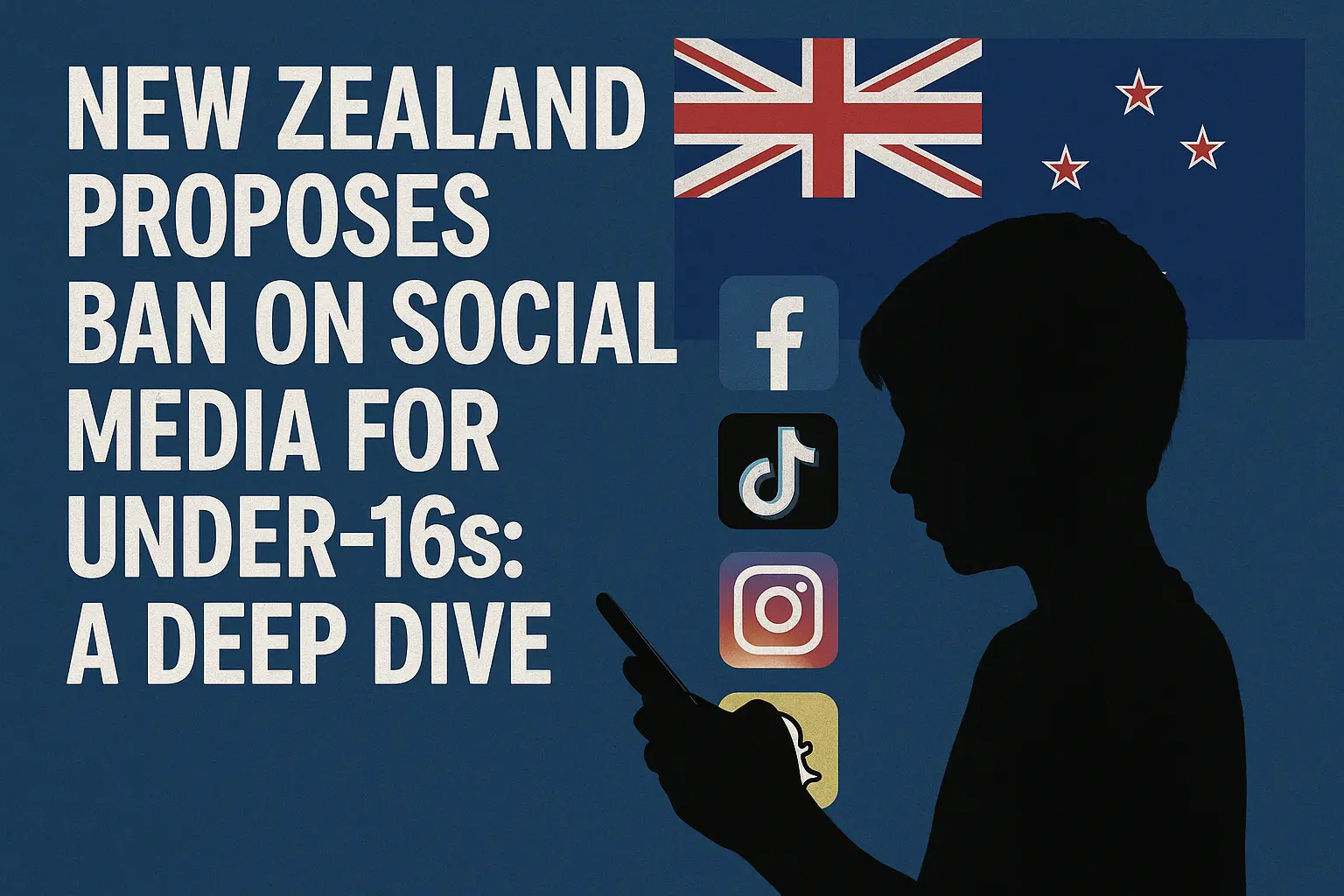
Table of Contents
ToggleContext
- New Zealand Prime Minister Christopher Luxon announced in May 2024 a proposal to ban children under the age of 16 from accessing social media platforms.
- The proposal is being advanced through a Members’ Bill introduced by National MP Catherine Wedd.
- This move is part of a broader global discussion about the impact of social media on young people and follows similar legislative efforts in other countries, notably Australia.
Rationale Behind the Proposal
- The primary driver for the proposed ban is the protection of children from the perceived negative impacts of social media on their mental health and well-being.
- Concerns raised include links between social media and increased rates of anxiety, depression, cyberbullying, and poor body image.
- Proponents highlight the risk of children being exposed to inappropriate content, online predators, and misinformation.
- The addictive design of platforms is cited, potentially leading to excessive screen time that displaces essential activities like sleep and study.
- Cyberbullying and online harassment are significant issues, with NetSafe reporting an 88% rise in complaints about sextortion in NZ since 2019.
- Prime Minister Luxon stated the need to “shield them from the perils of big tech platforms“.
- The proposed age of 16 is seen as allowing access after what is considered the “most vulnerable adolescent stage.”
Proposed Legislation and Key Provisions
- The proposal is currently a Members’ Bill under consideration in the New Zealand Parliament. (Note: The URL contains “2025”, but the content refers to the May 2024 proposal.)
- While specific details are still being finalised, the legislation is expected to require social media companies to implement robust age verification measures.
- The proposed laws have not yet explicitly named which social media companies would be covered.
- A 1News Verian Poll in late 2023 indicated that 68% of New Zealand voters supported restricting social media access for under-16s. (Note: The URL contains “2025”, but the content refers to the May 2024 proposal.)
Challenges and Criticisms
- Enforcement Difficulty: Implementing effective and foolproof age verification methods is a significant technical challenge; current methods can often be bypassed.
- Privacy Concerns: Monitoring online activity to enforce a ban raises substantial privacy issues.
- Impact on Marginalized Youth: Social media can be a vital tool for connection, community, and support for certain groups, particularly LGBTQ+ youth or those in isolated areas; a ban could remove these networks.
- Parental Rights: Critics argue the decision should be left to parents, not mandated by the state.
- Authoritarian Concerns: Some critics have labelled the proposal as authoritarian overreach, raising concerns about potential digital surveillance.
- Focus on Age vs. Content: Critics suggest focusing solely on age is less effective than addressing the harmful content and manipulative design features inherent in social media platforms themselves.
- An inquiry into the issue by the Social Services and Community Committee reportedly stopped short of recommending a complete ban, suggesting that evidence-based alternatives might be more effective.
International Comparisons: The Australian Context
- New Zealand’s proposal closely mirrors recent legislative action in Australia.
- In November 2024, Australia passed laws to restrict under-16s from accessing social media.
- Like New Zealand’s proposal, the Australian law also aims to place responsibility for age verification on social media platforms.
- However, key details on the implementation and enforcement of the Australian ban remain unclear, and the laws are not expected to take effect for at least 12 months.
- The Australian decision also faced criticism regarding the chosen age limit and whether it aligned with expert advice.
Implications for India
- While India currently does not have a proposal for a comprehensive nationwide ban on social media for under-16s, the discourse in New Zealand and the legislation in Australia hold relevance for future policy considerations.
- Policy Learning: These international developments serve as case studies for India, highlighting potential regulatory approaches, their rationales, and the associated technical and social challenges.
- Child Online Safety: The concerns driving the NZ proposal – related to mental health, cyberbullying, and harmful content – are highly pertinent in India, which has a large and rapidly growing young internet user base. Protecting children online is a significant policy goal.
- Platform Accountability: The focus on requiring platforms to implement age verification aligns with the global trend towards greater accountability for social media intermediaries, a direction India has also been moving towards through updated regulations.
- Existing Indian Framework: India’s current legal framework for online safety, primarily under the Information Technology Act, 2000 and the Information Technology (Intermediary Guidelines and Digital Media Ethics Code) Rules, 2021, focuses more on intermediary liability, grievance redressal mechanisms, and content moderation rules rather than a blanket age-based access ban across diverse platforms.
- Implementation Challenges: A nationwide ban in India would face enormous technical, logistical, and enforcement challenges due to scale, diversity, digital penetration variations, and infrastructure variability.
- Balancing Rights: Any such measure would require careful consideration of fundamental rights under the Indian Constitution, including the right to freedom of speech and expression (Article 19) and the potential impact on digital inclusion, access to information, and avenues for community engagement for young people.
Way Forward
- The New Zealand proposal is still in its legislative phase, and its final form and implementation details will depend on parliamentary processes, public consultation, and addressing the practical challenges raised.
- Addressing the complex issue of social media harms requires a multi-pronged approach, which may include enhanced digital literacy education, parental controls, industry self-regulation, and targeted content moderation alongside potential age restrictions or platform design changes.
- Policymakers globally, including in India, will continue to monitor the outcomes, effectiveness, and unintended consequences faced by countries like Australia and New Zealand as they implement and refine such regulatory measures.
- Any future regulatory approach in India would likely need to balance child protection goals with concerns about accessibility, privacy, proportionality, and the practicality of enforcement, building upon and adapting existing legal frameworks.

Leave a Reply